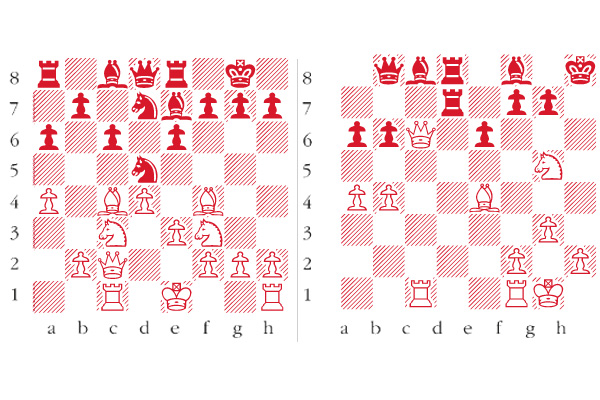As I write, the prestigious Alekhine Memorial tournament is drawing to a close. Brainchild of sponsor Andrei Filatov, this high-powered event is taking place partly in the Louvre in Paris and partly in the Mikhailovsky Palace of the State Russian Museum in St Petersburg, combining Mr Filatov’s twin passions for chess and art. The event celebrates the brilliant Russian world champion Alexander Alekhine and this week I give samples of his ingeniously creative mind. Next week I shall report on final results and best games.
Alekhine-Rubinstein; Carlsbad 1923; Queen’s Gambit Declined
1 d4 d5 2 c4 e6 3 Nf3 Nf6 4 Nc3 Be7 5 Bg5 Nbd7 6 e3 0-0 7 Rc1 c6 8 Qc2 a6 9 a4 Re8 10 Bd3 dxc4 11 Bxc4 Nd5 12 Bf4 (see diagram 1) White agrees to give up his bishop at f4 for the knight. On a dogmatic evaluation all the advantages will be on Black’s side: the two bishops and a spoiled pawn formation for the opponent. But a concrete approach shows that White has a considerable lead in development and the opportunity for play in the centre, and these factors outweigh the others. 12 … Nxf4 13 exf4 c5 14 dxc5 Qc7 15 0-0 Qxf4 16 Ne4 This pawn sacrifice is the only way for White to maintain his initiative and exploit his lead in development. 16 … Nxc5 17 Nxc5 Bxc5 18 Bd3 b6 19 Bxh7+ Kh8 In Alekhine’s opinion, the decisive mistake, since ‘after 19 … Kf8! it would have been very difficult for White to show how he could win, despite his positional superiority.’ 20 Be4 Ra7 20 … Rb8 was better. 21 b4 Now White wins by force. 21 … Bf8 22 Qc6 Rd7 23 g3 Qb8 24 Ng5 With the threat of 25 Nxf7+! 24 … Red8 (see diagram 2) 25 Bg6 The swiftest way of switching the queen to the h-file. The insipid 25 Bg2 is parried by the same move 25 … Qe5. 25 … Qe5 Rubinstein decides to give up the exchange. If 25 … fxg6 (25 … Kg8 26 Qe4!; 25 … Bb7 26 Qc4!), then 26 Qe4! Bd6 27 Qh4+ Kg8 28 Qh7+ Kf8 29 Qh8+ Ke7 30 Qxg7+ Ke8 31 Qg8+ Bf8 32 Qxg6+ Ke7 33 Qxe6 mate. 26 Nxf7+ Rxf7 27 Bxf7 Qf5 28 Rfd1 Rxd1+ 29 Rxd1 Qxf7 30 Qxc8 Kh7 31 Qxa6 Qf3 32 Qd3+ Black resigns
Alekhine notably defined himself as an artist in his chess credo, and chess and art have also come together recently in London with chess featuring heavily in the Man Ray exhibition at the National Portrait Gallery. I particularly liked the surrealist chessboard with the images of Salvador Dali and Max Ernst adorning every square. Meanwhile, the Marcel Duchamp tour de force (see this column of 23 February) continues at the Barbican, while a new contender for the most chess-inspired art runs at the David Zwirner Gallery, Mayfair, until 11 May with works by another Marcel, Marcel Dzama.
Raymond Keene
Great Alexander

issue 04 May 2013




Comments